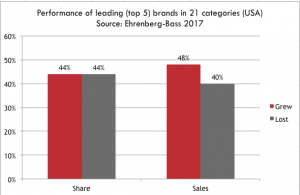Are big brands really dying?
The media is full of stories about big brands declining and even facing extinction. The dominant narrative is as follows:
- Big brands are losing out to smaller ‘insurgent brands’
- These smaller brands are using owned and earned social media content to win
- Millennial consumers are rejecting big brands in favour of new, smaller brands
- Declining loyalty is another nail in the coffin of big brands. ‘The Death Of Brand Loyalty: Cultural Shifts Mean It’s Gone Forever,’ screamed the headline of a recent Forbes article.
However, these stories are heavy on hype and hysteria and below we challenge their assumptions, drawing on a recent study by the Ehrenburg-Bass Institute1.
1. Are big brands in decline? NO
There is no evidence that big brands are, overall, in decline.
44% of the 105 leading US brands did LOSE share in the last 4-5 years.
But the same proportion, 44%, GAINED share.
This is based on Nielsen store scanner data for the top 5 brands in 21 packaged goods categories, over a 4-5 year period.
Looking at sales growth, the performance of big brands is slightly better, with 48% growing sales revenue (more than 5%), while 40% losing sales. Leading brands can lose share and still grow revenue if they are in a high growth category. For example, Chobani has driven market growth in yoghurt with premium propositions targeting new occasions. The leading brand, Yoplait, has lost share but maintained revenue. Danone (#2) has done even better, growing both sales revenue and value share.
So, the net result is that big brands in the US are in a similar position compared to 4-5 years ago.

2. Are earned/owned social media content the key to small brands growing? NO
There is an occasional winner of “the viral lottery”, such as the launch film for Dollar Shave Club and its millions of views on YouTube. But on the whole, the most effective campaigns combine paid, earned and owned media, as discussed in an earlier post. This partly reflects the decline of ‘organic’ reach on Facebook, which is now less than 10%.

Indeed, many new brands shaking up markets are using traditional media as a key part of their mix. Harry’s razors are using outdoor and TV to support their UK launch, for example. Chobani, the yoghurt brand mentioned earlier, launched its first national ad campaign within two years of launching in the US, and by 2014 was spending a whopping $56million.
Interestingly, Ehrenburg-Bass suggests that big brands have suffered not from doing too little digital marketing but from doing too much. “Many large brands over the past 5+ years moved large portions of their advertising budgets into new untested media options and away from big consistent creative campaigns. There have been many failures, though only a few have been publicised/documented.”
3. Are millennials rejecting big brands in favour of new, smaller brands? NO
Overall, brand rejection is low and mainly down to unfamiliarity, which if anything should favour well established, leading brands. The average brand rejection rate was only 13% in a study quoted in the Ehrenburg-Bass paper, based on 186 consumer goods brands from ten categories in 11 countries.
And specifically for people aged under 25, there are minimal differences in their purchase of leading brands compared to older people, when looking at the top 5 brands of fourteen categories. Indeed, in over 40% of category/year analyses, the leading brands actually had a higher share among younger consumers.
4. Is brand loyalty declining? NO
No general decline in brand loyalty was observed in a recent study researchers on 26 fast-moving-consumer-goods categories in the USA and UK over 6-13 years (Dawes et al 2015). Interestingly, in categories were a small decrease in loyalty was observed, a key factor was an increase in the number of SKUs. This is further evidence to support the idea that big brands can benefit from focusing on the core and reducing complexity.
In conclusion, the idea of big brands losing out to smaller brands looks like a myth. That said, big brands are on balance not winning either, with as many losing share as gaining. But I suggest this is to do not with the fact they are big and well established, but rather how well they are revitalising their core business.
In our next post, we will look at how big brands can fight back by remembering and refreshing what made them famous.
Sources:
1. https://www.marketingscience.info/are-big-brands-dying/

